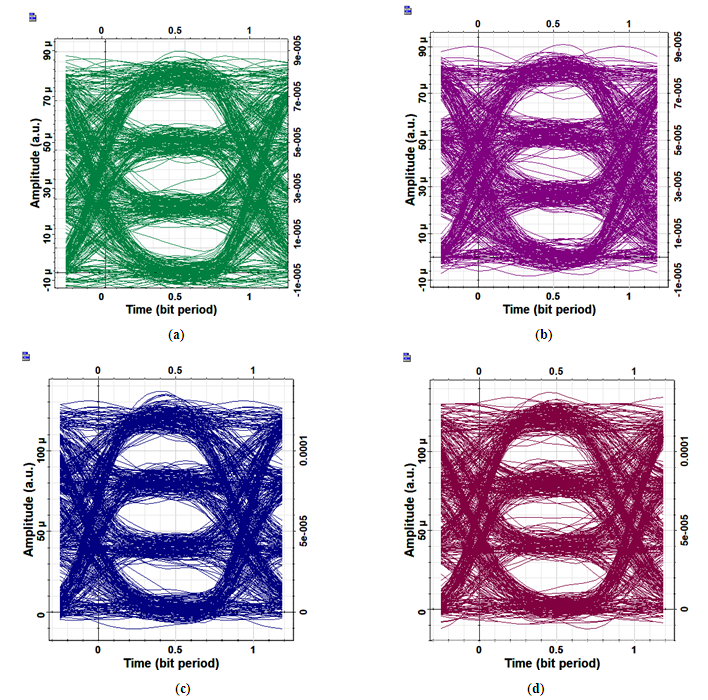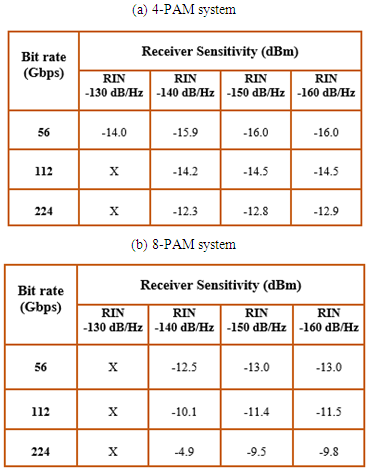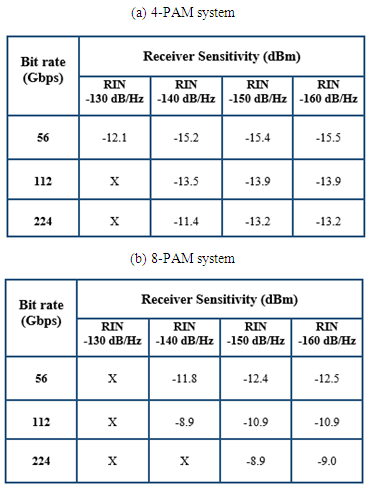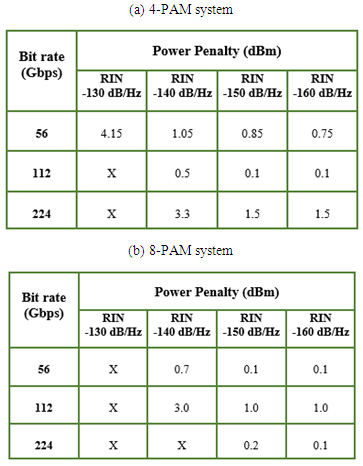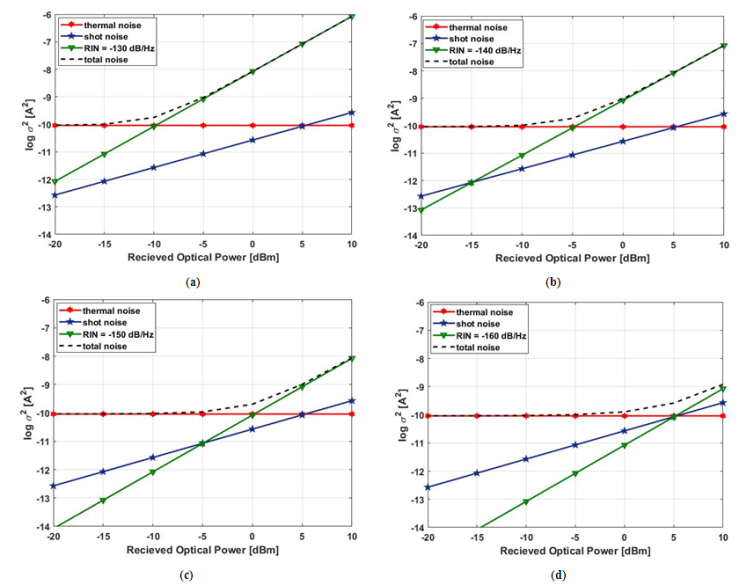| [1] | C. Kachris and I. Tomkos, “A survey on optical interconnects for data centers,” IEEE Communications Surveys and Tutorials, vol. 14, no. 4, pp. 1021-1036, Fourth Quarter 2012. |
| [2] | G. Zervas, H. Yuan, A. Saljoghei, Q. Chen, and V. Mishra, “Optically disaggregated data centers with minimal remote memory latency: technologies, architectures, and resource al-location,” Journal of Optical Communication and Networking, vol. 10, no. 2, pp. 270-285, Feb. 2018. |
| [3] | S. K. Kang, J. Y. Huh, J. H. Lee, and J. K. Lee, “ Low-cost and miniaturized 100-Gb/s (2 × 50 Gb/s) PAM-4 TO-packaged ROSA for data center networks,” Optics Express, vol. 26, no. 5, pp. 6172-6181, Mar. 2018. |
| [4] | D. Sadot, G. Dorman, A. Gorshtein, E. Sonkin, and O. Vi-dal1, “Single channel 112Gbit/sec PAM4 at 56Gbaud with digital signal processing for data centers applications,” Optics Express, vol. 23, no. 2, pp. 991-997, Jan. 2015. |
| [5] | E. El-Fiky, M. Chagnon, M. Sowailem, A. Samani, M. M. Osman, and D. V. Plant, “168-Gb/s single carrier PAM4 transmission for intra-data center optical interconnects,” IEEE Photonics Technology Letters, vol. 29, no. 3, pp. 314-317, Feb. 2017. |
| [6] | M. M. Osman, M. Chagnon, M. Poulin, S. Lessard, and D. V. Plant, “224-Gb/s 10-km transmission of PDM PAM-4 at 1.3 μm using a single intensity-modulated laser and a direct-detection MIMO DSP-based receiver,” IEEE Journal of Lightwave Technology, vol. 33, no. 7, pp. 1417-1424, Apr. 2015. |
| [7] | M. R.T. Tan, P. Rosenberg, W. V. Sorin, B. Wang, S. Mathai, G. Panotopoulos, and G. Rankin, “Universal photonic inter-connect for data centers,” IEEE Journal of Lightwave Technology, vol. 36, no. 2, pp. 175-180, Aug. 2017. |
| [8] | H. Y. Kao, Z. X. Su, H. Sh. Shih, Y. Ch. Chi, Ch. T. Tsai, H. C. Kuo, Ch. H. Wu, J. J. Jou, T. T. Shih, and G. R. Lin, “CWDM DFBLD transmitter module for 10-km interdata center with single-channel 50-Gbit/s PAM-4 and 62-Gbit/s QAM-OFDM,” IEEE Journal of Lightwave Technology, vol. 36, no. 3, pp. 703-711, Feb. 2018. |
| [9] | J. Zhang, J. Yu, F. Li, N. Chi, Z. Dong, and X. Li, “11 × 5 × 9.3Gb/s WDM-CAP-PON based on optical single-side band multi-level multi-band carrier-less amplitude and phase modulation with direct detection,” Optics Express, vol. 21, no. 16, pp. 188621-18848, Aug. 2013. |
| [10] | Y. Sun, R. L. Jr., R. Shubochkin, A. H. McCurdy, K. Balemarthy, D. Braganza, J. Kamino, T. Gray, W. Fan, K. Wade, F. Chang, D. Gazula, G. Landry, J. Tatum, and S. Bhoja, “SWDM PAM4 transmission over next generation wide-band multimode optical fiber,” IEEE Journal of Lightwave Technology, vol. 35, no. 4, pp. 690-697, Feb. 2015. |
| [11] | C. Prodaniuc, N. Stojanovic, F. Karinou, Z. Qiang, and R. Llorente, “Performance comparison between 4D trellis coded modulation and PAM-4 for low-cost 400 Gbps WDM optical networks,” IEEE Journal of Lightwave Technology, vol. 34, no. 22, pp. 5308-5316, Nov. 2016. |
| [12] | F. Gao, S. Zhou, X. Li, S. Fu, L. Deng, M. Tang, D. Liu, and Q. Yang, “2 × 64 Gb/s PAM-4 transmission over 70 km SSMF using O-band 18G-class directly modulated lasers (DMLs),” Optics Express, vol. 25, no. 7, pp. 7230-7237, Apr. 2017. |
| [13] | P. E. D. Cruz, T. M. F. Alves, and A. V. T. Cartaxo, “Virtual carrier-assisted DD-MB-OFDM schemes for UDWDM met-ro-access networks with improved tolerance to four-wave mixing,” IEEE Journal of Lightwave Technology, vol. 35, no. 20, pp. 4468-4478, Oct. 2017. |
| [14] | J. L. Wei, J. D. Ingham, D. G. Cunningham, R. V. Penty, and I. H. White, “Performance and power dissipation comparisons between 28 Gb/s NRZ, PAM, CAP and optical OFDM sys-tems for data communication applications,” IEEE Journal of Lightwave Technology, vol. 30, no. 20, pp. 3273-3280, Oct. 2012. |
| [15] | P. N. Ji, D. Qian, K. Kanonakis, C. Kachris, and I. Tom-kos, “Design and evaluation of a flexible-bandwidth OFDM-based intra-data center interconnect,” IEEE Journal of Selected Topics In Quantum Electronics, vol. 19, no. 2, Article no. 3700310, Mar./Apr. 2013. |
| [16] | X. Q. Liu, H. H. Chen, B. Y. Lyu, and W. X. Meng, “ Symbol cyclic shift equalization PAM-OFDM a low complexity CP-free OFDM scheme.” IEEE Transactions on Vehicular Technology, vol. 66, no. 7, pp. 5933-5946, Jul. 2017. |
| [17] | J. Shi, J. Zhang, N. Chi and J. Yu, “Comparison of 100G PAM-8, CAP-64 and DFTS OFDM with a band-width-limited direct-detection receiver,” Optics Express, vol. 25, no. 26, pp. 32254-32262, Dec. 2017. |
| [18] | N. S. Andr´e, H. Louchet, V. Filsinger, E. Hansen, and A. Richter, “OFDM and PAM comparison using a high baudrate low resolution IM/DD interface for 400G Ethernet access,” Optics Express, vol. 24, no. 11, pp. 11927-11931, May. 2016. |
| [19] | J. Shi, J. Zhang, Y. Zhou, Y. Wang, N. Chi and Jianjun Yu, “Transmission performance comparison for 100-Gb/s PAM-4, CAP-16, and DFT-S OFDM with direct detection,” IEEE Journal of Lightwave Technology, vol. 35, no. 23, pp. 5127-5133, Dec. 2017. |
| [20] | D. J. F. Barros, S. K. Wilson and J. M. Kahn, “Comparison of orthogonal frequency-division multiplexing and pulse-amplitude modulation in indoor optical wireless links,” IEEE Transactions on Communications, vol. 60, no. 1, pp. 153-163, Jan. 2012. |
| [21] | R. Asifa, and M. Haithemc, “10 Gbit/s mode-multiplexed QPSK transmission using MDM-to-MFDM based single coherent receiver for intra- and inter data center networking,” Optics Communications, vol., no., pp. 106-110, Jan. 2017. |
| [22] | D. L. Butler, M. Ju. Li, Sh. Li, Y. Geng, R. R. Khrapko, R. A. Modavis, V. N. Nazarov and A. V. Koklyushkin, “Space division multiplexing in short reach optical interconnects,” Journal of Lightwave Technology, vol. 35, no. 4, pp. 677-682, Feb. 2017. |
| [23] | H. Yuan, M. Furdek, A. Muhammad, A. Saljoghei, L. Wosinska, and G. Zervas, “Space-division multiplexing in data center networks: on multi-core fiber solutions and cross-talk-suppressed resource allocation,” IEEE Journal of Optical Communication and Networking, vol. 10, no. 4, pp. 272-288, Apr. 2018. |
| [24] | T. Mizuno, H. Takara, A. Sano and Y. Miyamoto, “Dense space-division multiplexed transmission systems using multi-core and multimode fiber,” IEEE Journal of Lightwave Technology, vol. 34, no. 2, pp. 582-592, Jan. 2016. |
| [25] | A. Grieco, G. Porter, and Y. Fainman, “Integrated space-division multiplexer for application to data center net-works,” IEEE Journal of Selected Topics in Quantum Electronics, vol. 22, no. 6, Article no. 8200106, Dec. 2016. |
| [26] | Z. Zhu, Sh. Zhong, L. Chen, and K. Chen, “Fully programmable and scalable optical switching fabric for petabyte data center,” Optics Express, vol. 23, no. 3, pp. 3563-3580, Feb. 2015. |
| [27] | L. Xue, L. Yi, H. Ji, P. Li, and W. Hu, “Symmetric 100-Gb/s TWDM-PON in O-band based on 10G-class optical devices enabled by dispersion-supported equalization,” IEEE Journal of Lightwave Technology, vol. 36, no. 2, pp. 580-586, Jan. 2018. |
| [28] | F. Bao, T. Morioka, L. K. Oxenløwe, and H. Hu1, “300 Gb/s IM/DD based SDM-WDM-PON with laserless ONUs,” Optics Express, vol. 26, no. 7, pp. 7949-7954, Apr. 2018. |
| [29] | R. Lin, J. V. Kerrebrouck, X. Pang, M. Verplaetse, O. Ozolins, A. Udalcovs, L. Zhang, L. Gan, M. Tang, S. Fu, R. Schatz, U. Westergren, S. Popov, D. Liu, W. Tong, T. D. Keulenaer, G. Torfs, J. Bauwelinck, X. Yin, and J. Chen, “Real-time 100 Gbps/λ/core NRZ and EDB IM/DD transmission over multi-core fiber for intra-datacenter communication networks,” Optics Express, vol. 26, no. 8, pp. 10519-10526, Apr. 2018. |
| [30] | T. N. Huynh, R. Watts, V. Vujicic, M. D. G. Pascual, C. Calo, K. Merghem, V. Panapakkam, F. Lelarge, A. Martinez, B. E. Benkelfat, A. Ramdane and L. P. Barry, “200-Gb/s bau-drate-pilot-aided QPSK/direct detection with single-section quantum-well mode-locked laser,” IEEE Photonics Journal, vol. 8, no. 2, Article no. 7903107, Apr. 2016. |
| [31] | H. Mardoyan, M. A. Mestre, J. M. Estar´an, F. Jorge, F. Blache, P. Angelini, A. Konczykowska, M. Riet, V. Nodji-adjim, J. Dupuy, and S. Bigo, "84-, 100-, and 107-GBd PAM-4 intensity modulation direct-detection transceiver for datacenter interconnects", IEEE Journal of Lightwave Technology, vol. 35, no. 6, pp. 1253-1259, Mar. 2017. |
| [32] | H. Mardoyan, M. A. Mestre, R. Rios-M¨uller, A. Konczykowska, J. Renaudier, F. Jorge, B. Duval, J. Y. Dupuy, A. Ghazisaeidi, Ph. Jennev´e, M. Achouche, and S. Bigo, “Single carrier 168-Gb/s line-rate PAM direct detection transmission using high-speed selector power DAC for optical interconnects”, IEEEE Journal of Lightwave Technology, vol. 34, no. 7, pp. 1593-1598, Apr. 2016. |
| [33] | H. Y. Chen, N. Kaneda, J. Lee, J. Chen, and Y. K. Chen1, “Optical filter requirements in an EML-based single-sideband PAM4 intensity-modulation and direct-detection transmission system,” Optics Express, vol. 25, no. 6, pp. 2852-2860, Mar. 2017. |
| [34] | N. Suzuki, H. Miura, K. Matsuda, R. Matsumoto, and K. Mo-toshima, “100 Gb/s to 1 Tb/s based coherent passive optical network technology,” IEEE Journal of Lightwave Technology, vol. 36, no. 8, pp. 1485-1491, Apr. 2018. |
| [35] | J. Cai, H. G. Batshon, M. V. Mazurczyk, O. V. Sinkin, D. Wang, M. Paskov, W. W. Patterson, C. R. Davidson, P. C. Corbett, G. M. Wolter, T. E. Hammon, M. A. Bolshtyansky, D. G. Foursa and A. N. Pilipetskii, “70.46 Tb/s over 7,600 km and 71.65 Tb/s over 6,970 km transmission in C+L band using coded modulation with hybrid constellation shaping and non-linearity compensation,” IEEE Journal of Lightwave Technology, vol. 36, no. 1, pp. 114-121, Jan. 2018. |
| [36] | V. Houtsma and D. V. Veen, “Bi-directional 25G/50G TDM-PON with extended power budget using 25G APD and coherent detection,” IEEE Journal of Lightwave Technology, vol. 36, no. 1, pp. 122-127, Jan. 2018. |
| [37] | R. V. D. Linden, N. C. Tran, E. Tangdiongga, and T. Koo-nen, “Optimization of flexible non-uniform multilevel PAM for maximizing the aggregated capacity in PON deployments,” IEEE Journal of Lightwave Technology, vol. 36, no. 12, pp. 2328-2336, June. 2018. |
| [38] | X. Guo, D. G. Cunningham, R. V. Penty, and I. H. White, “Optical equalizers for bandwidth-limited transmitters and PAM-based fiber optic links,” IEEE Journal of Lightwave Technology, vol. 36, no. 12, pp. 2484-2491, June. 2018. |
| [39] | Z. Li, A. Tan, Y. Song, Y. Li, J. Chen, and M. Wang, “ OOK-assisted adaptive equalization and timing recovery for PAM4 demodulation,” IEEE Photonics Journal, vol. 10, no. 2, Article no. 7201607, Apr. 2018. |
| [40] | I. N. Osahon, M. Safari, and W. O. Popoola, “10-Gb/s trans-mission over 10-m SI-POF with M-PAM and multilayer per-ceptron equalizer,” IEEE Photonics Technology Letters, vol. 30, no. 10, pp. 911-914, May 2018. |
| [41] | L. Tao, Y. Wang, Y. Gao, and N. Chi, “High order CAP system using DML for short reach optical communications,” IEEE Photonics Technology Letters, vol. 26, no. 13, pp. 1348-1351, July 2014. |
| [42] | Q. Chen, J. He, R. Deng, M. Chen, and L. Chen, “FFT-size efficient 4096-QAM OFDM for low-cost DML-based IMDD system,” IEEE Photonics Journal, vol. 8, no. 5, Article no. 7804010, Aug. 2016. |
| [43] | Q. Chen, J. He, R. Deng, M. Chen, and L. Chen, “FFT-size efficient 4096-QAM OFDM for low-cost DML-based IMDD system,” IEEE Photonics Journal, vol. 8, no. 5, Article no. 7804010, Oct. 2016. |
| [44] | X. Miao, M. Bi, Y. Fu, L. Li, and W. Hu, “Experimental study of NRZ, duobinary, and PAM-4 in O-band DML-based 100G-EPON,” IEEE Photonics Technology Letters, vol. 29, no. 17, pp. 1490-1493, Sept. 2017. |
| [45] | L. Tao, Y. Wang, J. Xiao, and N. Chi, “Enhanced performance of 400 Gb/s DML-based CAP systems using optical filtering technique for short reach communication,” Optics Express, vol. 22, no. 24, pp. 29331-29339, Dec. 2014. |
| [46] | T. C. Tzu, Y. Hsu, C. Y. Chuang, X. Wu, C. W. Chow, J. Chen, C. H. Yeh, and H. K. Tsang, “Equalization of PAM-4 signal generated by silicon microring modulator for 64-Gbit/s transmission,” IEEE Journal of Lightwave Technology, vol. 35, no. 22, pp. 4943-4948, Nov. 2017. |
| [47] | J. P. V. Engelen, L. Shen, G. Roelkens , Y. Jiao, M. K. Smit, and J. J. G. M. V. D. Tol, “A novel broadband electro-absorption modulator based on bandfilling in n-InGaAs: design and simulations,” IEEE Journal of Selected Topics in Quantum Electronics, vol. 24, no. 1, Article no. 3300108, Jan/Feb. 2018. |
| [48] | N. H. Zhu, Z. Shi, Z. K. Zhang, Y. M. Zhang, C. W. Zou, Z. P. Zhao, Y. Liu, W. Li, and M. Li, “Directly modulated semiconductor lasers.” IEEE Journal of Selected Topics in Quan-tum Electronics, vol. 24, no. 1, Article no. 1500219, Jan/Feb. 2018. |
| [49] | J. C. Cartledge and A. S. Karar, “100 Gb/s intensity modula-tion and direct detection,” IEEE Journal of Lightwave Technology, vol. 32, no. 16, pp. 2809-2814, Aug. 2014. |
| [50] | A. Abbasi, J. Verbist, L. A. Shiramin, M. Verplaetse, T. De Keulenaer, R. Vaernewyck, R. Pierco, A. Vyncke, X. Yin, G. Torfs, G. Morthier, J. Bauwelinck, and G. Roelkens, “100-Gb/s electro-absorptive duobinary modulation of an InP-on-Si DFB laser,” IEEE Photonics Technology Letters, vol. 30, no. 12, pp. 1095-1098, Jun. 2018. |
| [51] | S. K. Kang, J. Y. Huh, J. H. Lee, and J. K. Lee, “Low-cost and miniaturized 100-Gb/s (2 × 50 Gb/s) PAM-4 TO-packaged ROSA for data center networks,” Optics Express, vol. 26, no. 5, pp. 6172-6181, Mar. 2018. |
| [52] | J. Chen, Z. S. He, T. Lengyel, K. Szczerba, P. Westbergh, J. S. Gustavsson, H. Zirath, and A. Larsson, “An energy efficient 56 Gbps PAM-4 VCSEL transmitter enabled by a 100 Gbps driver in 0.25 μm InP DHBT technology,” IEEE Photonics Technology Letters, vol. 34, no. 21, pp. 4954-4964, Nov. 2016. |
| [53] | B. D. Feris, Ph. Gravey, P. Morel, M. L. Moulinard, M. Morvan, and A. Sharaiha, “Dimensioning of 112G optical-packet-switching-based interconnects for energy-efficient data centers,” IEEE Journal of Optical Communication and Networking, vol. 9, no. 4, pp. B124-B136, Apr. 2017. |
| [54] | J. Shi, J. Zhang, Y. Zhou, Y. Wang, N. Chi, and J. Yu, “Transmission performance comparison for 100-Gb/s PAM-4, CAP-16, and DFT-S OFDM with direct detection,” IEEE Journal of Lightwave Technology, vol. 35, no. 23, pp. 5127-5133, Dec. 2017. |
| [55] | S. Kanazawa, Y. Nakanishi, S. Tsunashima, H. Yamazaki, Y. Ueda, W. Kobayashi, Y. Muramoto, H. Ishii, and H. Sanjoh, “Equalizer-free transmission of 100-Gb/s 4-PAM signal generated by flip-chip interconnection EADFB laser module,” IEEE Journal of Lightwave Technology, vol. 35, no. 4, pp. 775-780, Feb. 2017. |
| [56] | L. Xue, L. Yi, H. Ji, P. Li, and W. Hu, “Symmetric 100-Gb/s TWDM-PON in O-band based on 10G-class optical devices enabled by dispersion-supported equalization,” IEEE Journal of Lightwave Technology, vol. 36, no. 2, pp. 580-586, Jan. 2018. |
| [57] | K. Fang, J. Yu, H. Wang, and X. Li, “56 Gbps signal generation from one 10-G class laser diode for 400G intra-data center interconnection,” Optical Fiber Technology, vol. 36, pp. 210-214, Apr. 2017. |
| [58] | R. R. M¨uller, J. Renaudier, P. Brindel, A. Ghazisaeidi, I. Fernandez, P. Tran, C. Simonneau, L. Schmalen, and G. Charlet, “Spectrally-efficient 400-Gb/s single carrier transport over 7 200 km,” IEEE Journal of Lightwave Technology, vol. 33, no. 7, pp. 1402-1407, Apr. 2015. |
| [59] | F. Karinou, N. Stojanovic, C. Prodaniuc, M. Agustin, J. Kropp, and N. N. Ledentsov, “Solutions for 100/400-Gb/s ethernet systems based on multimode photonic technologies,” IEEE Journal of Lightwave Technology, vol. 35, no. 15, pp. 3214-3222, Aug. 2017. |
| [60] | G. Khanna, T. Rahman, E. D. Man, E. Riccardi, A. Pagano, A. C. Piat, S. Calabrò, B. Spinnler, D. Rafique, U. Feiste, H. D. Waardt, B. S. Krombholz, N. Hanik, T. Drenski, M. Bohn, and A. Napoli, “Single-carrier 400G 64QAM and 128QAM DWDM field trial transmission over metro legacy links,” IEEE Photonics Technology Letters, vol. 29, no. 2, pp. 189-192, Jan. 2017. |
| [61] | J. M. F`abrega, M. S. Moreolo, A. Mayoral, R. Vilalta, R. Casellas, R. Mart´ınez, R. Mu˜noz, Y. Yoshida, K. Kitayama, Y. Kai, M. Nishihara, R. Okabe, T. Tanaka, T. Takahara, J. C. Rasmussen, N. Yoshikane, X. Cao, T. Tsuritani, I. Morita, K. Habel, R. Freund, V. L´opez, A. Aguado, S. Yan, D. Sime-onidou, T. Szyrkowiec, A. Autenrieth, M. Shiraiwa, Y. Awaji, and N. Wada, “Demonstration of adaptive SDN orchestration: a real-time congestion-aware services provisioning over OFDM-Based 400G OPS and Flexi-WDM OCS,” IEEE Journal of Lightwave Technology, vol. 35, no. 3, pp. 506-512, Feb. 2017. |
| [62] | Y. Nakanishi, T. Ohno, T. Yoshimatsu, and H. Sanjoh, “High-sensitivity 4-channel receiver module with avalanche photodiode for 400-Gbit/s Ethernet,” NTT Technical, vol. 14, no. 9, pp. 1-6, Sept. 2016. |
| [63] | P. Groumas, V. Katopodis, J. H. Choi, H. G. Bach, J. Y. Dupuy, A. Konczykowska, Z. Zhang, P. Harati, E. Miller, A. Beretta, L. Gounaridis, F. Jorge, V. Nodjiadjim, A. Dede, A. Vannucci, G. Cangini, R. Dinu, N. Keil, N. Grote, H. Avram-opoulos, and C. Kouloumentas, “Multi-100 GbE and 400 GbE interfaces for intra-data center networks based on arrayed transceivers with serial 100 Gb/s operation,” IEEE Journal of Lightwave Technology, vol. 33, no. 4, pp. 943-954, Feb. 2015. |
| [64] | N. Eiselt, J. Wei, H. Griesser, A. Dochhan, M. H. Eiselt, J. P. Elbers, J. J. V. Olmos, and I. T. Monroy, “Evaluation of re-al-time 8 × 56.25 Gb/s (sdG) PAM-4 for inter-data center application over 80 km of SSMF at 1550 nm,” IEEE Journal of Lightwave Technology, vol. 35, no. 4, pp. 955-962, Feb. 2017. |
| [65] | N. S. Andr´e, H. Louchet, V. Filsinger, E. Hansen, and A. Richter1, “OFDM and PAM comparison using a high bau-drate low resolution IM/DD interface for 400G Ethernet access,” Optics Express, vol. 24, no. 11, pp. 11926-11931, May. 2016. |
| [66] | C. Prodaniuc, N. Stojanovic, F. Karinou, Z. Qiang, and R. Llorente, “Performance comparison between 4D trellis coded modulation and PAM-4 for low-cost 400 Gbps WDM optical networks,” IEEE Journal of Lightwave Technology, vol. 34, no. 22, pp. 5308-5316, Nov. 2016. |
| [67] | R. Lin, J. V. Kerrebrouck, X. Pang, M. Verplaetse, O. Ozolins, A. Udalcovs, L. Zhang, L. Gan, M. Tang, S. Fu, R. Schatz, U. Westergren, S. Popov, D. Liu, W. Tong, T. D. Keulenaer, G. Torfs, J. Bauwelinck, X. Yin, and J. Chen, “Real-time 100 Gbps/λ/core NRZ and EDB IM/DD transmission over multi-core fiber for intra-datacenter communication networks,” Op-tics Express, vol. 26, no. 8, pp. 10519-10526, Apr. 2018. |
| [68] | X. Pang, O. Ozolins, S. Gaiarin, A. Kakkar, J. R. Navarro, M. I. Olmedo, R. Schatz, A. Udalcovs, U. Westergren, D. Zibar, S. Popov, and G. Jacobsen, “Experimental study of 1.55-μm EML-based optical IM/DD PAM-4/8 short reach systems,” IEEE Photonics Technology Letters, vol. 29, no. 6, pp. 523-526, Mar. 2017. |
| [69] | F. Karinou, N. Stojanovic, A. Daly, Ch. Neumeyr, and M. Ortsiefer, “1.55-μm long-wavelength VCSEL-based optical interconnects for short-reach networks,” IEEE Journal of Lightwave Technology, vol. 34, no. 12, pp. 2897-2904, Jun. 2016. |
| [70] | K. Zhong, X. Zhou, T. Gui, L. Tao, Y. Gao, W. Chen, J. Man, L. Zeng, A. P. T. Lau, and Ch. Lu, “Experimental study of PAM-4, CAP-16, and DMT for 100 Gb/s short reach optical transmission systems,” Optics Express, vol. 23, no. 2, pp. 1176-1189, Jan. 2015. |
| [71] | N. Eiselt, J. Wei, H. Griesser, A. Dochhan, M. H. Eiselt, J. P. Elbers, J. J. V. Olmos, and I. T. Monroy, “Evaluation of re-al-time 8x56.25 Gb/s (400G) PAM-4 for inter-data center ap-plication over 80 km of SSMF at 1550 nm,” IEEE Journal of Lightwave Technology, vol. 35, no. 4, pp. 955-962, Feb. 2017. |
| [72] | W. Miao, H. d. Waardt, R. v. d. Linden, and N. Calabretta, “Assessment of scalable and fast 1310-nm optical switch for high-capacity data center networks,” IEEE Photonics Technology Letters, vol. 29, no. 1, pp. 98-101, Jan. 2017. |
| [73] | M. Mosman, M. Chagnon, M. Poulin, S. Lessard, and D. V. Plant, “224-Gb/s 10-km transmission of PDM PAM-4 at 1.3 μm using a single intensity-modulated laser and a direct-detection MIMO DSP-based receiver,” IEEE Journal of Lightwave Technology, vol. 33, no. 7, pp. 1417-1424, Apr. 2015. |
| [74] | K. Zhong, X. Zhou, Y. Gao, W. Chen, J. Man, L. Zeng, A. P. T. Lau, and Ch. Lu, “140-Gb/s 20-km transmission of PAM-4 signal at 1.3 μm for short reach communications,” IEEE Pho-tonics Technology Letters, vol. 27, no. 16, pp. 1757-1760, Aug. 2015. |
| [75] | K. Szczerba, P. Westbergh, J. Karout, J. S. Gustavsson, Å. Haglund, M. Karlsson, P. A. Andrekson, E. Agrell, and A. Larsson, “4-PAM for high-speed short-range optical communications,” Journal of Optical Communication and Networking, vol. 4, no. 11, pp. 885-894, Nov. 2012. |



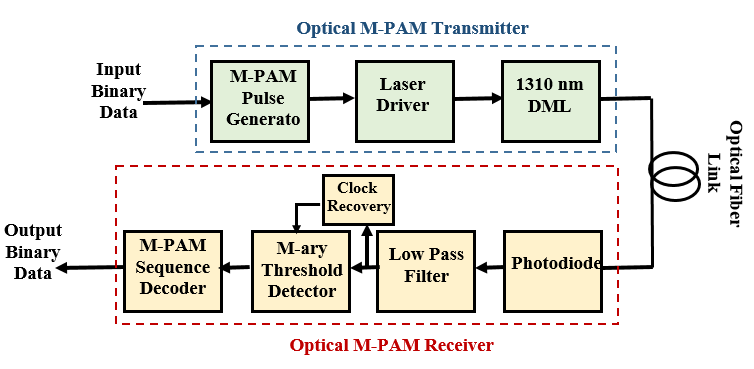

 . The average value of the drive current (under the assumption of equal-probability symbols) is given by
. The average value of the drive current (under the assumption of equal-probability symbols) is given by
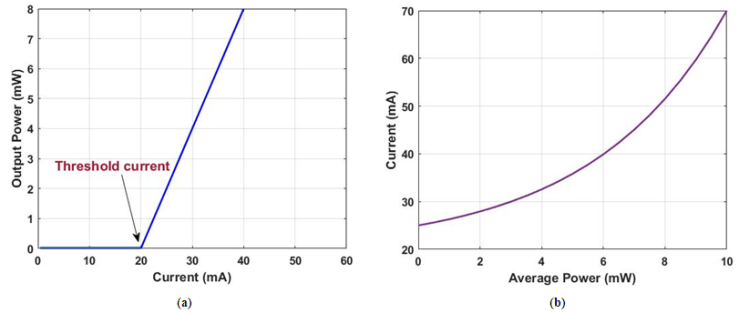

 , the average power Pav emitted from the laser is given by
, the average power Pav emitted from the laser is given by




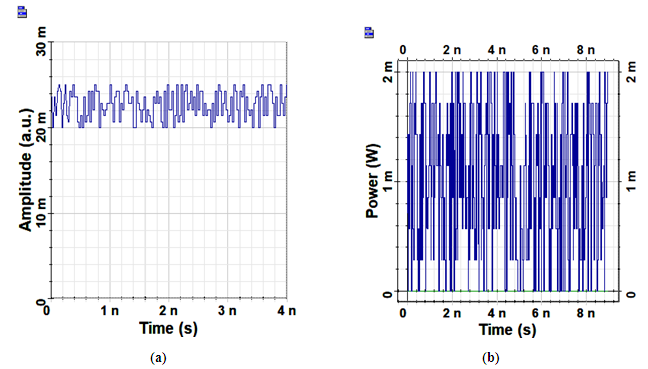
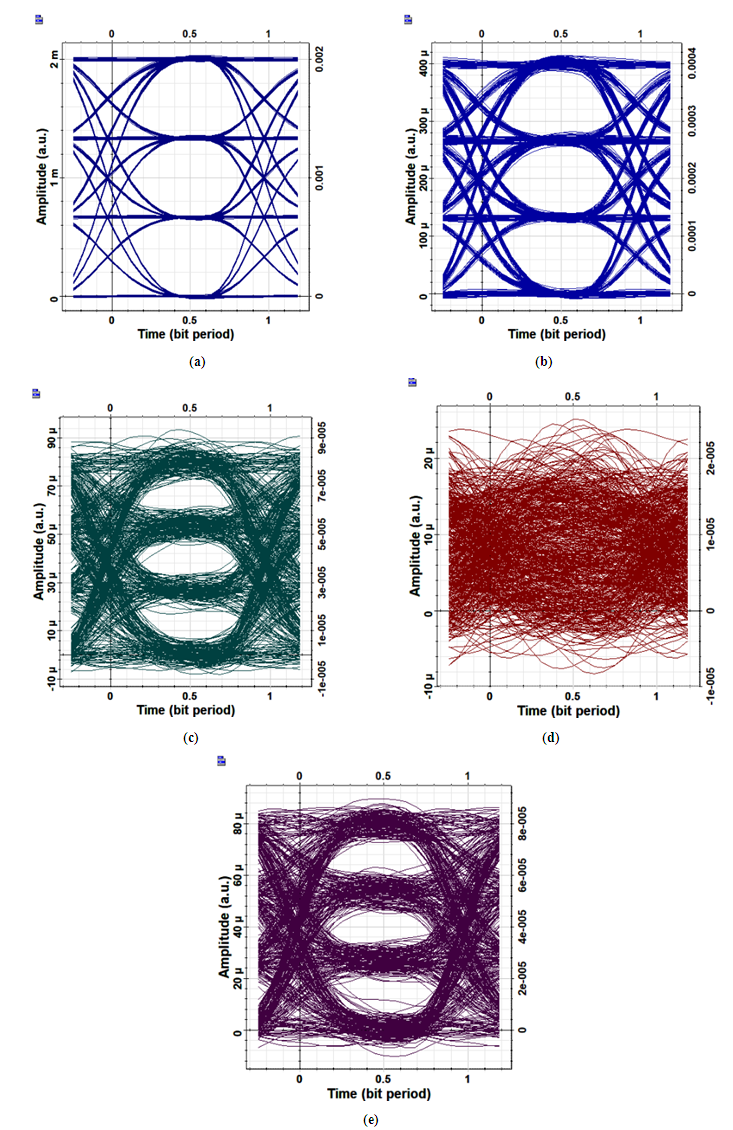
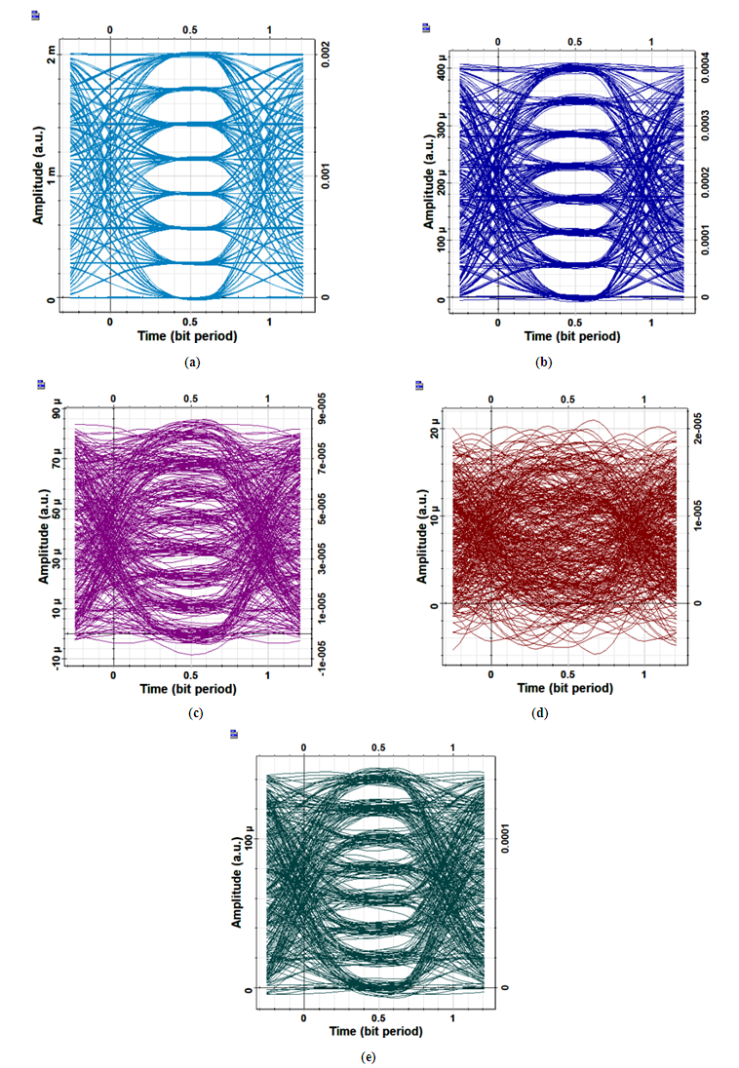
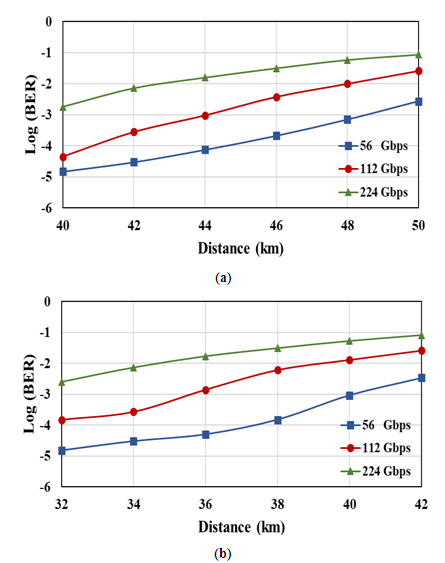

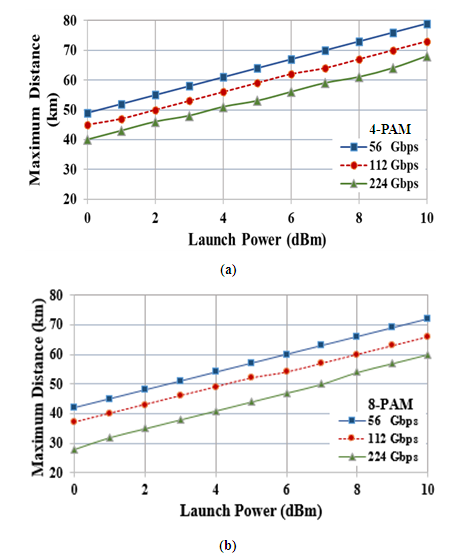
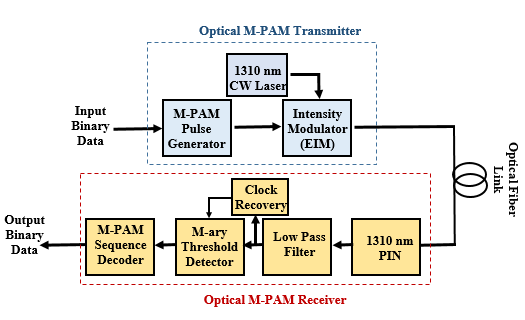

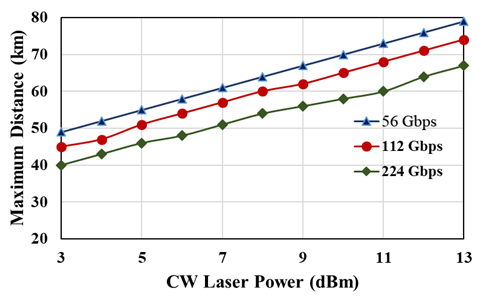
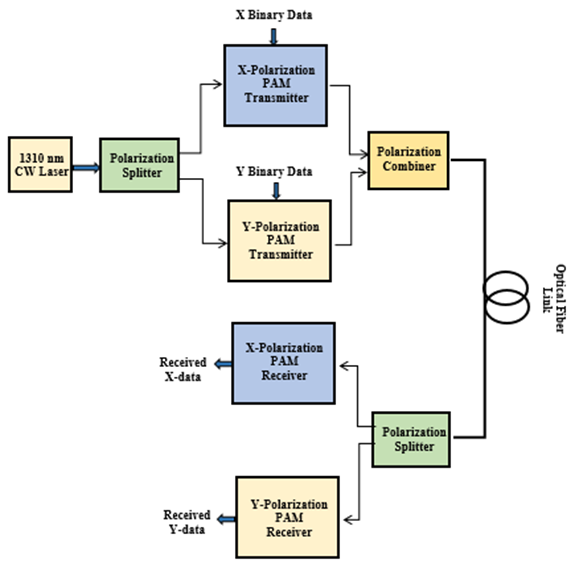
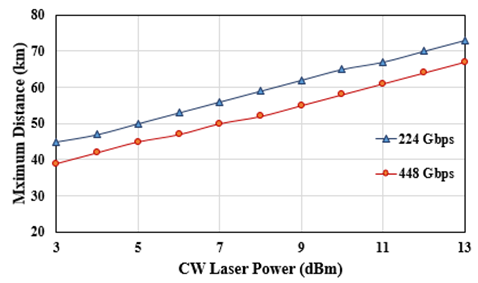






 is the quantum efficiency of the PD, q is the magnitude of the electronic charge, h = 6.6026×10-34 Js Planck’s constant, and f = c/
is the quantum efficiency of the PD, q is the magnitude of the electronic charge, h = 6.6026×10-34 Js Planck’s constant, and f = c/ is the frequency of the incident optical signal with
is the frequency of the incident optical signal with  it’s wavelength and c is the speed of light in free space.The noise associated with the photodetection process comes mainly from three noise sources, namely thermal noise associated with the front-end electronic amplifier used to amplify the photocurrent, shot noise due to quantum nature of the photodetection, and relative intensity noise (RIN) which characterizes the intensity noise of the used transmitter laser. The variance of the total noise current can be written as
it’s wavelength and c is the speed of light in free space.The noise associated with the photodetection process comes mainly from three noise sources, namely thermal noise associated with the front-end electronic amplifier used to amplify the photocurrent, shot noise due to quantum nature of the photodetection, and relative intensity noise (RIN) which characterizes the intensity noise of the used transmitter laser. The variance of the total noise current can be written as
 and
and  are the variances corresponding to thermal noise, shot noise, and RIN, respectively, and they are calculated as follows [75]
are the variances corresponding to thermal noise, shot noise, and RIN, respectively, and they are calculated as follows [75]


 with Id is the dark current) is negligible compared with photocurrent shot noise
with Id is the dark current) is negligible compared with photocurrent shot noise  and therefore
and therefore  is not included in eqn. 10. This assumption is justified in practical receivers since Id << IPh.(ii) There are two signal-dependent noise sources, namely photocurrent shot noise and RIN-related noise whose variances proportional to IPh and I2Ph, respectively. This implies that low-RIN laser sources should be used.(iii) The receiver bandwidth B is related to the symbol rate
is not included in eqn. 10. This assumption is justified in practical receivers since Id << IPh.(ii) There are two signal-dependent noise sources, namely photocurrent shot noise and RIN-related noise whose variances proportional to IPh and I2Ph, respectively. This implies that low-RIN laser sources should be used.(iii) The receiver bandwidth B is related to the symbol rate  where Rb is the bit rate. To ensure zero intersymbol interference (ISI) at the input of the receiver, 0.5Rs ≤ B ≤ Rs for the equalized pulse shape. Note that each of the noise variance scales linearly with symbol rate. At fixed bit rate Rb, going from 2-PAM to 4- and 8-PAM signaling will reduce the total noise
where Rb is the bit rate. To ensure zero intersymbol interference (ISI) at the input of the receiver, 0.5Rs ≤ B ≤ Rs for the equalized pulse shape. Note that each of the noise variance scales linearly with symbol rate. At fixed bit rate Rb, going from 2-PAM to 4- and 8-PAM signaling will reduce the total noise  to half and third, respectively.
to half and third, respectively. are plotted in logarithmic scale versus the average received power Pr measured in dBm. The results are repeated in the Appendix for RL=50Ω. The 50 Ω load resistance corresponds to low impedance receiver front-end electronic amplifier which yields a 10-21 W/Hz thermal noise power spectral density (PSD) according to eqn. 11a. The 550 Ω load resistance corresponds to advanced receiver front-end electronic amplifier which has a transimpedance (feedback) configuration with 550 Ω feedback resistance. The feedback amplifier configuration offers the required bandwidth with higher value of resistance compared with low-impedance counterpart but with reduced thermal noise PSD = 10-22 W/Hz when 550 Ω resistance is used. Investigating these figures reveals that(i) Both Log
are plotted in logarithmic scale versus the average received power Pr measured in dBm. The results are repeated in the Appendix for RL=50Ω. The 50 Ω load resistance corresponds to low impedance receiver front-end electronic amplifier which yields a 10-21 W/Hz thermal noise power spectral density (PSD) according to eqn. 11a. The 550 Ω load resistance corresponds to advanced receiver front-end electronic amplifier which has a transimpedance (feedback) configuration with 550 Ω feedback resistance. The feedback amplifier configuration offers the required bandwidth with higher value of resistance compared with low-impedance counterpart but with reduced thermal noise PSD = 10-22 W/Hz when 550 Ω resistance is used. Investigating these figures reveals that(i) Both Log  and Log
and Log  increase linearly with Pr (dBm) but with different slops which reflect the degree of dependence of these noise components on the photocurrent IPh. Recall that Pr (dBm)=10 Log [Pr (mW)] = 30 + 10 Log [Pr (W)], then eqns. 11b and 11c can be rewritten as
increase linearly with Pr (dBm) but with different slops which reflect the degree of dependence of these noise components on the photocurrent IPh. Recall that Pr (dBm)=10 Log [Pr (mW)] = 30 + 10 Log [Pr (W)], then eqns. 11b and 11c can be rewritten as 

 and
and  increases linearly
increases linearly  with slope equals 0.1 and 0.2, respectively.(ii) The contribution of shot noise becomes higher than that of the thermal noise when the received optical power exceeds a certain level (denoted here by (Pr) cross-shot). This Pr level equals to 5 and -5 dBm for the parameters values used in the simulation and when RL =50 Ω and 550 Ω, respectively. Generally, according to eqns. 11a and 11b
with slope equals 0.1 and 0.2, respectively.(ii) The contribution of shot noise becomes higher than that of the thermal noise when the received optical power exceeds a certain level (denoted here by (Pr) cross-shot). This Pr level equals to 5 and -5 dBm for the parameters values used in the simulation and when RL =50 Ω and 550 Ω, respectively. Generally, according to eqns. 11a and 11b


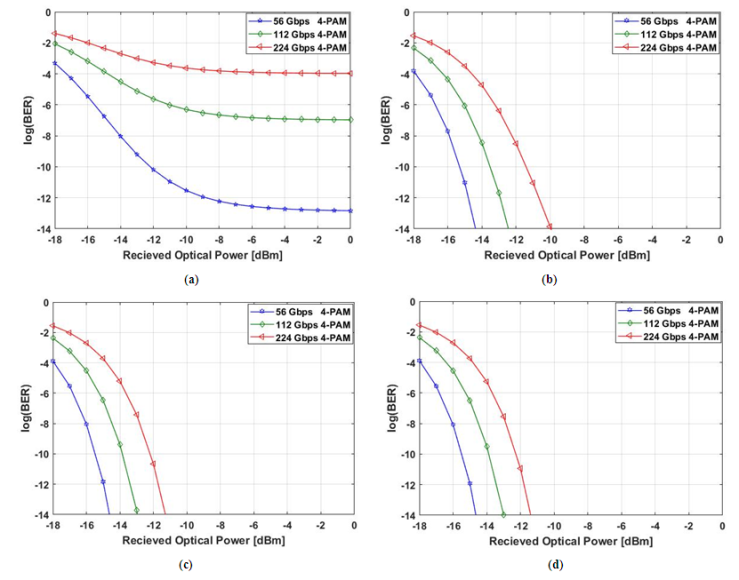
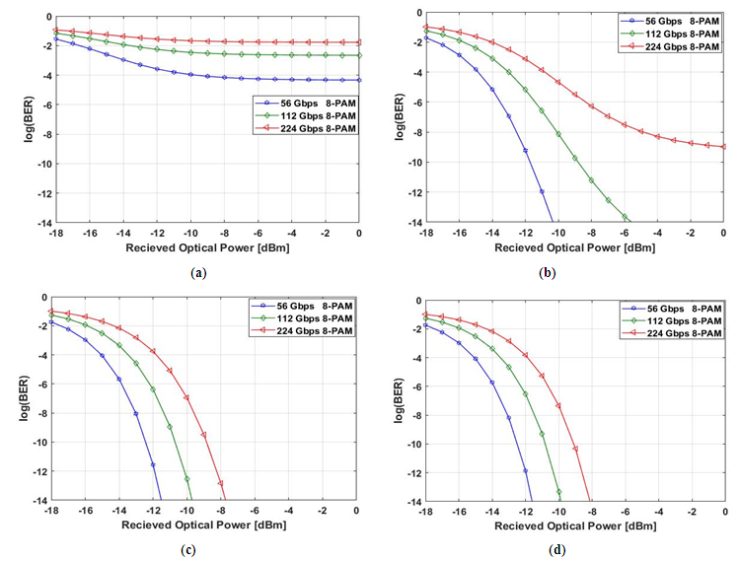
 . From eqn.7, the BERfloor can be estimated as
. From eqn.7, the BERfloor can be estimated as 



 Abstract
Abstract Reference
Reference Full-Text PDF
Full-Text PDF Full-text HTML
Full-text HTML


